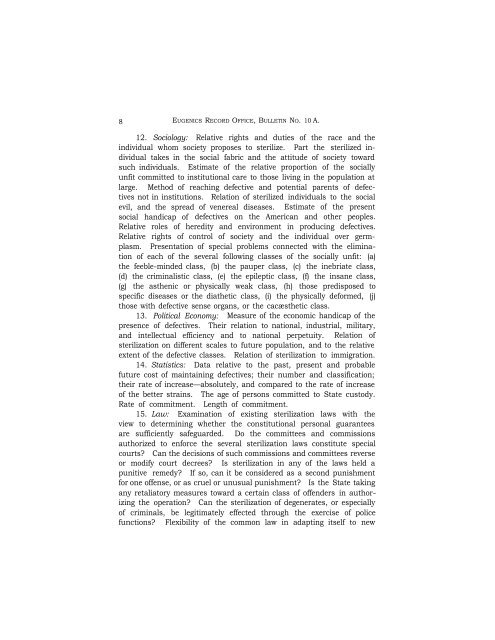Eugenics Record Office. BULLETIN No. 10A - DNA Patent Database ...
Eugenics Record Office. BULLETIN No. 10A - DNA Patent Database ...
Eugenics Record Office. BULLETIN No. 10A - DNA Patent Database ...
You also want an ePaper? Increase the reach of your titles
YUMPU automatically turns print PDFs into web optimized ePapers that Google loves.
8<br />
EUGENICS RECORD OFFICE, <strong>BULLETIN</strong> NO. 10 A.<br />
12. Sociology: Relative rights and duties of the race and the<br />
individual whom society proposes to sterilize. Part the sterilized in-<br />
dividual takes in the social fabric and the attitude of society toward<br />
such individuals. Estimate of the relative proportion of the socially<br />
unfit committed to institutional care to those living in the population at<br />
large. Method of reaching defective and potential parents of defec-<br />
tives not in institutions. Relation of sterilized individuals to the social<br />
evil, and the spread of venereal diseases. Estimate of the present<br />
social handicap of defectives on the American and other peoples.<br />
Relative roles of heredity and environment in producing defectives.<br />
Relative rights of control of society and the individual over germ-<br />
plasm. Presentation of special problems connected with the elimina-<br />
tion of each of the several following classes of the socially unfit: (a)<br />
the feeble-minded class, (b) the pauper class, (c) the inebriate class,<br />
(d) the criminalistic class, (e) the epileptic class, (f) the insane class,<br />
(g) the asthenic or physically weak class, (h) those predisposed to<br />
specific diseases or the diathetic class, (i) the physically deformed, (j)<br />
those with defective sense organs, or the cacæsthetic class.<br />
13. Political Economy: Measure of the economic handicap of the<br />
presence of defectives. Their relation to national, industrial, military,<br />
and intellectual efficiency and to national perpetuity. Relation of<br />
sterilization on different scales to future population, and to the relative<br />
extent of the defective classes. Relation of sterilization to immigration.<br />
14. Statistics: Data relative to the past, present and probable<br />
future cost of maintaining defectives; their number and classification;<br />
their rate of increase—absolutely, and compared to the rate of increase<br />
of the better strains. The age of persons committed to State custody.<br />
Rate of commitment. Length of commitment.<br />
15. Law: Examination of existing sterilization laws with the<br />
view to determining whether the constitutional personal guarantees<br />
are sufficiently safeguarded. Do the committees and commissions<br />
authorized to enforce the several sterilization laws constitute special<br />
courts? Can the decisions of such commissions and committees reverse<br />
or modify court decrees? Is sterilization in any of the laws held a<br />
punitive remedy? If so, can it be considered as a second punishment<br />
for one offense, or as cruel or unusual punishment? Is the State taking<br />
any retaliatory measures toward a certain class of offenders in author-<br />
izing the operation? Can the sterilization of degenerates, or especially<br />
of criminals, be legitimately effected through the exercise of police<br />
functions? Flexibility of the common law in adapting itself to new



